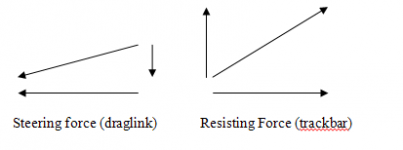JK's JK
Banned
This is what I got from Wikipedia, the free encyclopedia.
Bump steer or roll steer is the term for the tendency of the wheel of a car to steer as it moves upwards. It is typically measured in degrees of steer per metre of upwards motion or degrees per foot.
On modern cars the front of the tire moves outwards as the suspension is raised, a process known as the front wheels "toeing out". This gives roll understeer. The rear suspension is usually set up to minimise bump steer, where possible.
Typical values are from two to ten degrees per metre, for the front wheels.
Excessive bump steer increases tire wear and makes the vehicle more difficult to handle on rough roads.
Solid axles generally have zero bump steer, but still have roll steer, in most cases. That is, if the wheels move upwards by the same amount, they tend not to steer.
Roll steer is an important part of the budget used to define a vehicle's understeer, known as a Bundorf analysis.
Sounds like a solid axle doesnt have bump steer form what I'm reading it has roll steer.
This is the difference between the two.
Difference between Bump Steer and Roll Steer
In a bump steer, both wheels rise together. In roll steer, one wheel rises as the other falls. Typically this produces "toe in" on one wheel, and "toe out" on the other, thus producing a steering effect.
Roll steer is usually measured in degrees of toe per degree of roll, but can also be measured in degrees of toe per metre of wheel travel.
Bump steer or roll steer is the term for the tendency of the wheel of a car to steer as it moves upwards. It is typically measured in degrees of steer per metre of upwards motion or degrees per foot.
On modern cars the front of the tire moves outwards as the suspension is raised, a process known as the front wheels "toeing out". This gives roll understeer. The rear suspension is usually set up to minimise bump steer, where possible.
Typical values are from two to ten degrees per metre, for the front wheels.
Excessive bump steer increases tire wear and makes the vehicle more difficult to handle on rough roads.
Solid axles generally have zero bump steer, but still have roll steer, in most cases. That is, if the wheels move upwards by the same amount, they tend not to steer.
Roll steer is an important part of the budget used to define a vehicle's understeer, known as a Bundorf analysis.
Sounds like a solid axle doesnt have bump steer form what I'm reading it has roll steer.
This is the difference between the two.
Difference between Bump Steer and Roll Steer
In a bump steer, both wheels rise together. In roll steer, one wheel rises as the other falls. Typically this produces "toe in" on one wheel, and "toe out" on the other, thus producing a steering effect.
Roll steer is usually measured in degrees of toe per degree of roll, but can also be measured in degrees of toe per metre of wheel travel.
Last edited:

